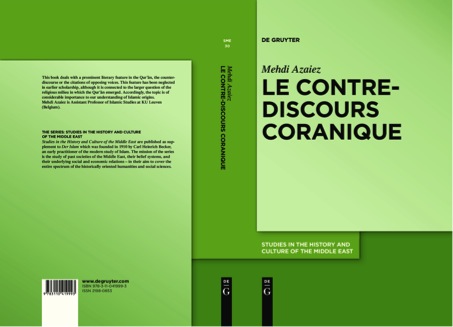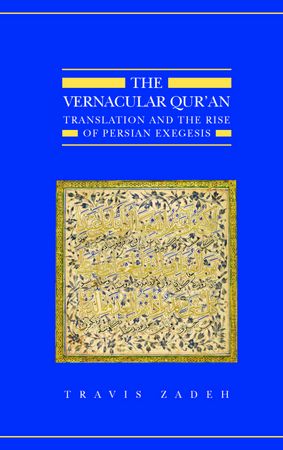Qur’anic Counter-Discourse
by Mehdi Azaiez*
My new book, Le contre-discours coranique (Berlin: DeGruyter, 2015), focuses on a distinctive literary form in the Qur’an: “counter-discourse”—that is, the discourse of the Qur’an’s opponents as represented in the qur’anic text itself. Qur’anic counter-discourse appears in the form of direct reported speech, easily identifiable by the formula “they say.” The first example in the canonical text appears in Q Baqarah 2:8:
وَمِنَ النَّاسِ مَنْ يَقُولُ آمَنَّا بِاللَّهِ وَبِالْيَوْمِ الْآخِرِ وَمَا هُمْ بِمُؤْمِنِينَ
wa-min al-nās man yaqūlu āmannā bi’llāh wa-bi’l-yawm al-ākhir wa-mā hum bi-mu’minīn
Among the people are those who say, “We believe in God and the Last Day,” but they do not believe.
We can easily recognize the statement marked above in bold as the words of an (anonymous) opponent. My book identifies such statements throughout the qur’anic text, and examines them from historical, linguistic, and rhetorical perspectives.
Historically, counter-discourse implies the existence of vocal opponents to the Qur’an. What, then, does such discourse reveal about these opponents’ identities and beliefs, and about the historical context in which they reportedly spoke? Linguistically, counter-discourse in the Qur’an consists of distinctive narrative and dialogical forms. What forms are used in the qur’anic text to record opponents’ sayings, and what forms are used to refute them? Rhetorically, counter-discourse seems to pose interesting ontological and argumentative paradoxes. How does a text considered by most Muslims to be divine speech incorporate the speech of those who are not divine, and who deny the Qur’an’s message? How does the qur’anic text give voice to opposition without legitimating it?
My book aims to address these questions in three stages. The first identifies and defines the subject (Chapters I-III), the second determines and quantifies a corpus of evidence (Chapters IV-V), and the third analyzes this corpus by querying its themes, forms, and evolution (Chapters VI-IX). This last stage includes both synchronic and diachronic approaches. I first undertake an intratextual reading of the Qur’an. I describe the discursive operations through which the Qur’an represents multiple voices (e.g. God, believers, disbelievers) and constructs counter-discourse and apologetic discourse. Indeed, the speech of opponents is never reported without reply, and we repeatedly encounter the emblematic formula of “they say . . . say . . .” (yaqūlūna . . . fa-qul . . .). This dialogue between counter-discourse and reply creates what can be called an argumentative question (a recent linguistic notion in the theory of argumentation). With this in mind, I analyze reported oppositional speech in terms of the replies it entails, paying special attention to how one counter-discourse can receive multiple different qur’anic replies.
I then undertake an intertextual reading, querying the possible usage of counter-discourse in late antique texts, namely biblical and parabiblical literatures such as Christian apocrypha and the Talmud. This considerable task is only introduced in my book. Comparative analysis of some eschatological qur’anic and talmudic counter-discourses has already yielded encouraging results, as I have shown in “Les contre-discours eschatologiques dans le Coran et le traité du Sanhédrin” (in Déroche et al., eds., Les origines du Coran: Le Coran des origines [Paris: Académie des Inscriptions et Belles-Lettres, 2015], 111-128).
Throughout Le contre-discours coranique, I propose a formal typology of qur’anic counter-discourse, assess its distribution and importance, and outline its formal and discursive features (e.g., types of refutation, types of opponent, and internal evolution). Diagrams, graphs, and tables accompany the study in order to enhance our appreciation of this discursive corpus.
Let me now highlight some of my findings. In quantitative terms, 588 verses contain some type of counter-discourse. There are three types: past (e.g., of Pharaoh or the people of Noah), present (e.g., against the Qur’an or Muhammad), and future (e.g., of the damned in hell). Respectively, they comprise 38%, 46%, and 16% of all qur’anic counter-discourses. The majority of “present” counter-discourses represent the important mise en scene of adversaries situated in the time of the qur’anic revelations. These adversaries argue against God (29%), against Muhammad (27%), against the Qur’an (20%), against final judgment (19%), and against the community of believers (6%). On the other hand, qur’anic replies to their arguments aim to strengthen the Qur’an’s author (the qur’anic God), its primary addressee and enunciator (Muhammad), its actual enunciation (the Qur’an as a process of divine revelation), its message (especially one of the most recurrent themes: eschatology), and its secondary addressees (the first community of believers). The presentation of counter-discourses and their replies is done with strategic constraints that aim at denigrating the qur’anic opponents. These strategies are principally isolation and focus. With the help of examples from Sūrat al Furqān and Sūrat al-Wāqiʿah analyzed in Chapter VIII of my book, I demonstrate how the counter-discourses are neutralized by the fact that they are in the minority, decentralized, and surrounded by statements that refute them.
An important aim of Le contre-discours coranique is to address the question of how analysis of counter-discourse can help us better understand the socio-historical context of the emergence of the Qur’an. To say that the text of the Qur’an reflects a context of sectarian polemics is not new. What my book offers, however, is a fresh analysis of present counter-discourses that strongly supports recent suggestions—namely by Crone, Hawting, and Reynolds—to enroll qur’anic polemics in the religious controversies of Late Antiquity.
It is likely that the historical portraits of Muhammad’s opponents in the traditional Islamic sources (especially the sīrah literature) are problematic. To put it more precisely, the opponents of the Qur’an were probably not pagans. Their objections, as reported in qur’anic counter-discourse, are mostly monotheistic in character. Statements that imply that they may have been pagan are very few (see my Chapter VII), and appear to be based on a discursive strategy of exaggeration that is typical of polemical language. Moreover, there are striking similarities of themes and formulations in present counter-discourses between the Qur’an and parabiblical texts. Especially in eschatological counter-discourses, one can easily perceive how the text of the Qur’an reflects a theological agenda that is distinct and yet nonetheless enrolled in a continuum with Talmudic literary forms, themes, arguments, and counter-arguments. On the whole, qur’anic counter-discourse seem more readily explainable in light of late antique Christian-Jewish polemics rather than solely through the lens of later Muslim exegesis.
*Mehdi Azaiez is Assistant Professor of Islamic Studies at KU Leuven (Belgium).
© International Qur’anic Studies Association, 2015. All rights reserved.




